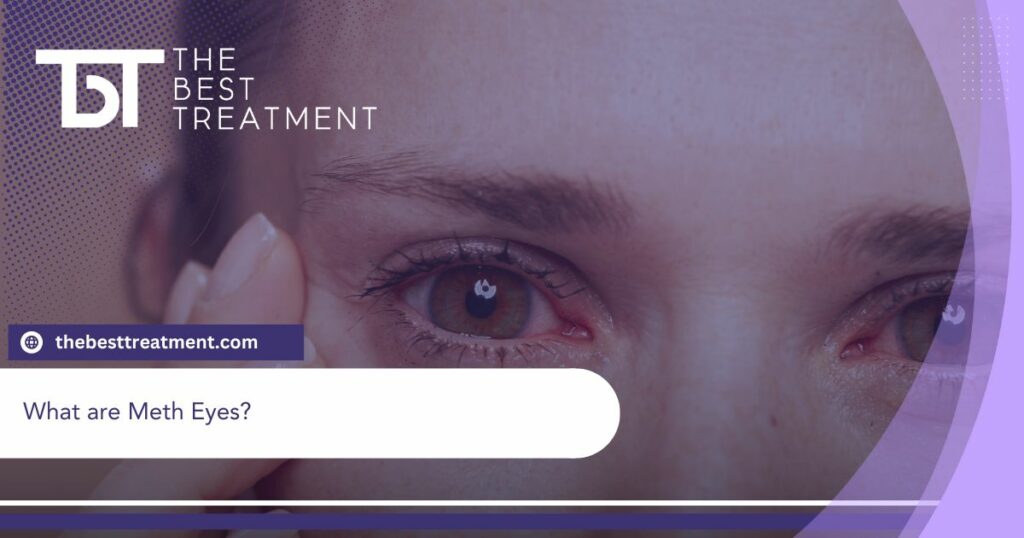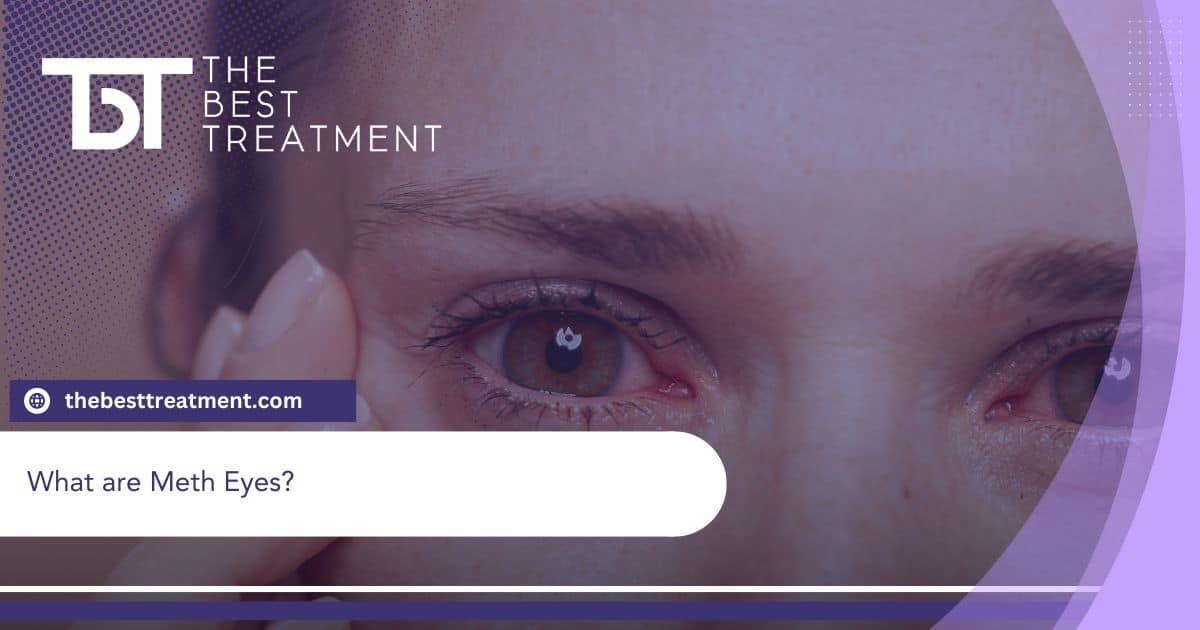Table of Contents
Methamphetamine, commonly known as meth, is a powerful and illegal stimulant drug that is sold illegally on the streets. In 2021, studies found that about 2.5 million people used meth and 1.6 million were addicted to it.
Meth abuse and addiction are extremely dangerous, and may lead to overdose, death, and a range of long-term side effects. Approximately 32,537 people died from an overdose involving stimulants like meth in 2021.
Spotting the signs of meth addiction is essential in helping a loved one find treatment and avoid the negative consequences of meth abuse. Meth abuse can cause a variety of physical and psychological changes, including changes to vision, eye appearance, and ocular health. In this article, you will learn what ‘meth eyes’ are and how meth affects vision as well as other areas of the body.
If you or a loved one are struggling with meth addiction and are ready to take the first steps to recovery, please contact our team at The Best Treatment Center today.
What are Meth Eyes?
The term ‘meth eyes’ refers to the various changes methamphetamine can have on the eyes. People usually use the term to describe physical signs associated with meth abuse, but it can also refer to the overall eye health or condition of someone who has a history of meth use.
People who are under the influence of methamphetamine may exhibit several noticeable changes, including:
Pupil Dilation
One of the most common physical signs of meth abuse is dilated pupils. Pupil dilation makes the pupil, the black part of the eye, become much larger than it normally is. Dilated pupils can occur after using any type of stimulant or hallucinatory drug, including meth, cocaine, psilocybin mushrooms, and LSD.
Under the influence of meth, pupil dilation can last several hours and may make individuals more sensitive to light. People may also have a wide-eyed, startled or surprised appearance.
Rapid Eye Movements
Like other central nervous system (CNS) stimulants, meth can cause jittery, twitchy, or rapid eye movements. These rapid, involuntary movements of the eyes are called nystagmus and often subside as the effects of meth wear off.
Glassy Eyes
People who use meth often have a glassy or glossy look in their eyes. Their eyes may look glazed over or as if they aren’t focusing on any particular thing. They may have a shiny or even teary appearance.
Bloodshot Eyes
Meth can cause sudden blood pressure fluctuations, high blood pressure, and constricted blood vessels. It can also make people stay awake for days at a time, leading to lack of sleep and irritated eyes. These factors combined often result in red, bloodshot eyes.
Discharge
Another eye-related side effect of meth abuse is dry eyes and abnormal discharge. This can occur when the eyes are too dry or if an infection appears.
More Ways Meth Can Affect Vision and Ocular Health
Meth abuse can cause serious and sometimes permanent vision damage. It is also associated with an increased risk for various eye diseases that can result in vision impairment or loss.
- Corneal ulcerations (wounds on the surface of the eye)
- Blurry vision
- Distorted vision
- Decreased depth perception
- Keratitis (inflammation of the cornea)
- Endophthalmitis (inflammation inside the eye)
- Dry eyes
- Reduced tear production
- Vision loss
- Blindness
Heavy, long-term meth abuse can cause total vision loss or blindness. This is typically the result of the way meth affects the small, fragile blood vessels in the eye. A decrease in blood supply to these blood vessels can cause the retina’s cells to die, potentially leading to complete vision loss. The condition is known as Central Retinal Vein Occlusion (CRVO). CRVO is sometimes called retinal vascular occlusive disease or RVOD.
Additionally, snorting meth can cause crystalline retinopathy. People with this condition have a build up of crystals that have formed in the retina of the eye. These crystals can cause reduced visual acuity, meaning the ability to see fine details.
Heavy meth users may also be at an increased risk for:
- Glaucoma – A condition marked by increased pressure within the eye leading to optic nerve damage and vision loss.
- Cataracts – Progressive clouding of the eye’s lens, causing blurry vision and eventual vision impairment if left untreated.
- Macular degeneration – Deterioration of the macula, the central part of the retina, resulting in gradual loss of central vision.
- Keratoconus – Progressive thinning and bulging of the cornea, leading to distorted vision and potential vision loss.
- Methamphetamine-associated retinopathy (MAR) – Damage to the retina caused by methamphetamine use, leading to visual disturbances and potential vision loss.
If you or a loved one are abusing meth, it’s important to seek professional help. Seeking treatment for meth addiction and staying in recovery can help prevent vision loss and other long-term effects of substance abuse.
Treatment for eye damage caused by meth use not only includes staying sober, but also:
- Medications – Corticosteroids are sometimes used to reduce swelling and inflammation.
- Surgery – In some cases, surgery can repair structural damage to the eye.
- Lifestyle changes – Quitting smoking, staying hydrated, and avoiding bright lights can help ease symptoms.
- Eye drops – Lubricating eye drops or artificial tears can help relieve itching, dryness, and irritation.
Long-Term Effects of Meth Abuse on the Rest of the Body
Meth abuse doesn’t just cause eye problems–it can affect a person’s overall health. Common physical and psychological effects of long-term meth abuse are:
- Physical dependence and addiction
- Dental problems such as tooth decay and ‘meth mouth’
- Sores on the skin, sometimes called ‘meth sores’
- Premature aging
- Rapid weight loss and malnutrition
- Strained relationships and finances
- Memory loss
- Cognitive decline
- Neurological damage
- Kidney and/or liver damage
- Increased risk for infections such as HIV/AIDS, Hepatitis, and others due to poor hygiene, skin picking, and contaminants in the drug
- Mental health problems including depression, paranoia, hallucinations, and aggressive behaviors
- Sleep disturbances and insomnia
- Sexual dysfunction
- Strain on the cardiovascular system increasing the risk of:
- Heart palpitations
- Hypertension
- Irregular heartbeat
- Heart attack
- Stroke
People who abruptly stop taking meth after long-term use may result in painful and unpleasant withdrawal symptoms, including:
- Fatigue
- Increased appetite
- Vivid dreams
- Depression
- Anxiety
- Irritability
- Agitation
- Psychosis
- Paranoia
- Suicidal thoughts
- Cravings
- Insomnia
- Tremors
- Muscle aches
- Sweating
- Chills
- Headaches
- Difficulty concentrating
- Decreased libido
- Increased need for sleep
These symptoms are best managed at a medical detox or addiction treatment facility.
Comprehensive Meth Addiction Treatment
At The Best Treatment Center, we not only help clients abstain from drugs and alcohol, but we also help them restore their physical and mental health. Our comprehensive approach addresses all aspects of addiction, allowing individuals to restore their health and reclaim control over their lives. We also address any co-occurring mental health issues that contribute to substance abuse.
Our goal here at The Best Treatment Center is to support our guests during their recovery journey and always encourage their continuous growth. We know that the more supported our guests feel, the more courage they will have to continue in their battle against a methamphetamine addiction. With a supportive environment and evidence-based treatments, our clients can detox safely and obtain the tools and support they need to stay sober.
To learn more about our treatment programs or to get started with a confidential, risk-free assessment, please contact us today.
Medically Reviewed: September 25, 2019

All of the information on this page has been reviewed and verified by a certified addiction professional.










